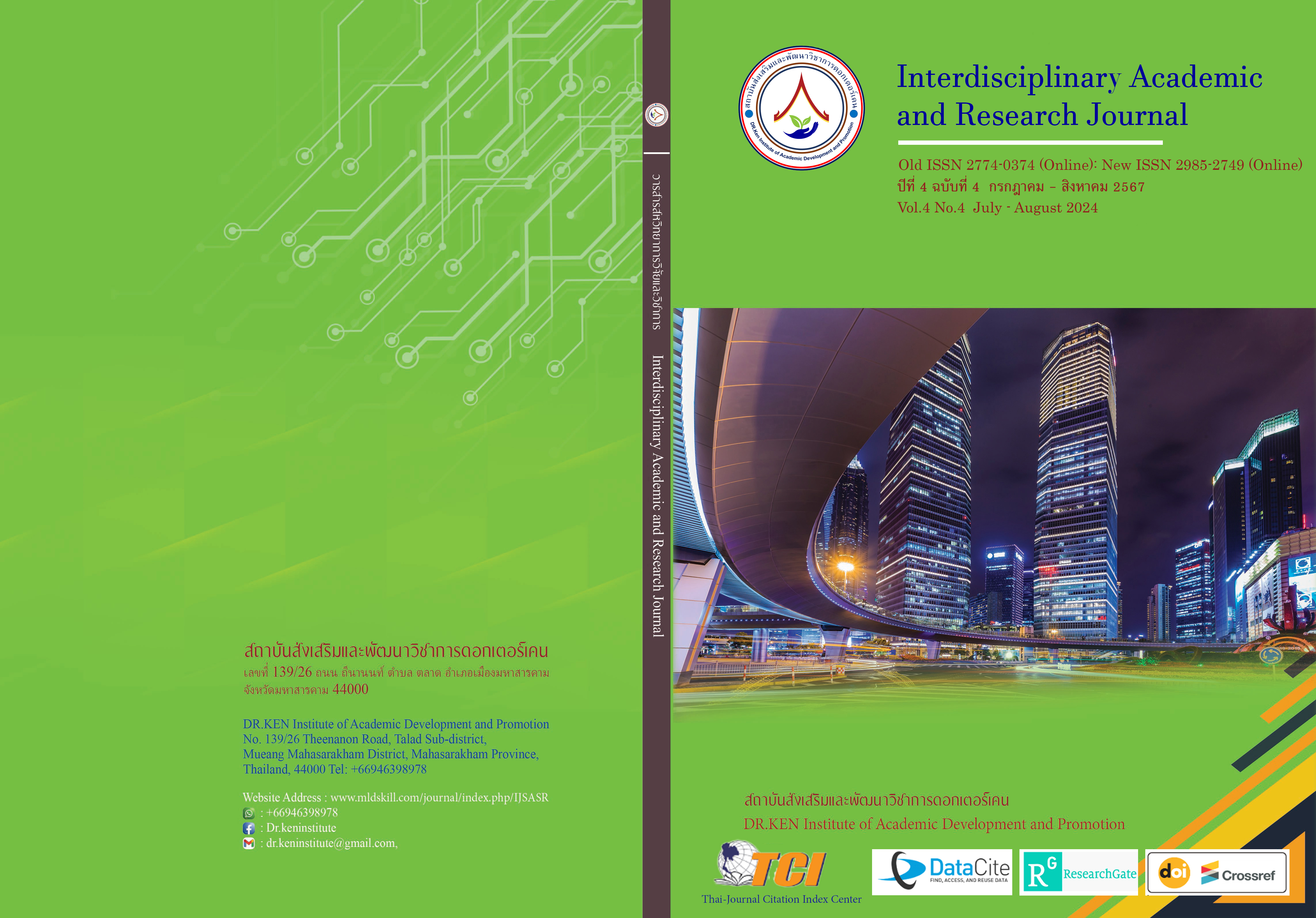The Study of Needs of Liberal Arts Program in Tourism and Recreation, Thailand National Sports University Si Sa Ket Campus
DOI:
https://doi.org/10.60027/iarj.2024.279087Keywords:
Stakeholder; , Tourism and Recreation program; , Thailand National Sports University.Abstract
Background and Aims: The Tourism and Recreation program aims to produce graduates who are experts in the tourism business, have leadership in recreational activities, and possess foreign language skills relevant to their professions. The graduates were able to apply their knowledge to benefit the society. This research aimed to study and analyze the opinions of stakeholders of the Bachelor of Arts program in Tourism and Recreation, Thailand National Sports University, Si Sa Ket Campus.
Methodology: The sample groups included 1) 396 high school students in Sisaket Province, and an accidental sampling was utilized, 2) 28 graduates, 3) 2 employers, and 4) 2 representatives from public and private sectors, and a purposive sampling was applied. The total sample size comprised 428 participants. The research tools included 1) a questionnaire on the desire to pursue further studies, 2) a satisfaction questionnaire for graduates, and 3) an interview form for employers and government agencies. The statistics of the study were Percentage, Mean, Standard deviation, and Content analysis.
Results: 1) The factors with the greatest influence on the decision to pursue further studies were facility factors, followed by public relations, university image, and study costs. 2) The graduates were most satisfied with the teaching and learning, followed by the availability of useful information resources for graduates, and the curriculum. 3) The graduates had well-rounded individuals in their assigned tasks. They could communicate well in English, had good interpersonal skills, had proper etiquette, were willingness to help colleagues, had respect for superiors, and were punctuality.
Conclusion: The Bachelor of Arts program in Tourism and Recreation, Thailand National Sports University Si Sa Ket Campus, had information on the factors influencing the decision-making of high school students in Sisaket province to pursue further studies, as well as the opinions of graduates, employers, and recommendations from government and private organizations in the tourism and recreation industry. This could be used to plan for the development and improvement of the program's quality.
References
คณะศิลปศาสตร์. (2566). รายงานผลการดำเนินงานของหลักสูตร (มคอ.7) ประจำปีการศึกษา 2566. ศรีสะเกษ: มหาวิทยาลัยการกีฬาแห่งชาติ วิทยาเขตศรีสะเกษ
จักรวาล วงศ์มณี, อาภารัตน์ ประทีปะเสน, กุลวดี ละม้ายจีน, เนียนนิภา สำเนียงเสนาะ, ภูวดล งามมาก, และพุทธพร โคตรภัทร. (2564). แนวทางการพัฒนาหลักสูตรสาขาวิชาการจัดการการท่องเที่ยวและการบริการ คณะมนุษยศาสตร์และสังคมศาสตร์ มหาวิทยาลัยราชภัฏอุบลราชธานี. วารสารมนุษยศาสตร์และสังคมศาสตร์ มหาวิทยาลัยราชภัฏอุบลราชธานี. 12(1), 30-43.
จาตุรนต์ สุขุมาลพงษ์, สมนึก ภัททิยธนี, และฐิตาภรณ์ เวียงวิเศษ. (2560). ความต้องการเข้าศึกษาต่อในมหาวิทยาลัยราชภัฏอุดรธานีของนักเรียนชั้นมัธยมศึกษาปีที่ 6 ภาคตะวันออกเฉียงเหนือตอนบน. วารสารศึกษาศาสตร์ฉบัับวิจัยบัณฑิตศึกษามหาวิทยาลัยขอนแก่น. 11(2), 31-40.
ใจทิพย์ เชื้อรัตนพงษ์. (2539). การพัฒนาหลักสูตร: หลักการและแนวปฏิบัติ. กรุงเทพฯ: โรงพิมพ์อลีน เพรส.
ชัญญา ตันสกุล และ กัญญามน กาญจนาทวีกูล. (2563). การพัฒนาสมรรถนะบุคลากรด้านอุตสาหกรรมการท่องเที่ยวและบริการตามกรอบอาเซียนของสถานประกอบการเขตพื้นที่ภาคใต้ฝั่งอันดามัน. วารสารวิชาการ สถาบันเทคโนโลยีแห่งสุวรรณภูมิ. 6(2), 23-42.
ธํารง บัวศรี. 2542. ทฤษฎีหลักสูตร : การออกแบบหลักสูตรและพัฒนา. กรุงเทพฯ : พัฒนาศึกษา.
บุญชม ศรีสะอาด. (2553). การวิจัยเบื้องต้น. พิมพ์ครั้งที่ 5. กรุงเทพฯ : สุวีริยาสาส์น.
ปรีดาวรรณ อินทรวิมลศรี. (2548). รูปแบบการมีส่วนร่วมของผู้ปกครองในการจัดการศึกษาของโรงเรียนกรุงเทพมหานคร. ปริญญานิพนธ์การศึกษามหาบัณฑิต มหาวิทยาลัยศรีนครินทรวิโรฒ ประสานมิตร.
เมตต์ เมตต์การุณ. (2547). การบริหารจัดการศึกษาแบบมีส่วนร่วม: ประชาชนองค์กรปกครองส่วนท้องถิ่นและราชการ. กรุงเทพฯ : บุ๊ค พอยท์.
ราชกิจจานุเบกษา (2565). ประกาศเรื่องเกณฑ์มาตรฐานหลักสูตรระดับปริญญาตรี พ.ศ. 2565. ราชกิจจานุเบกษา เล่ม 139 ตอนพิเศษ212ง วันที่ 9 กันยายน 2565
วิทวัส เหล่ามะลอ. (2562). ปัจจัยที่มีผลต่อการตัดสินใจเข้าศึกษาต่อระดับปริญญาตรีของนักศึกษา มหาวิทยาลัยขอนแก่น ประจำปีการศึกษา 2562. มหาวิทยาลัยขอนแก่น
ศศิวิมล จุลศิลป์. (2553). รูปแบบการมีส่วนร่วมของชุมชนในการนำภูมิปัญญาท้องถิ่นมาใช้ในการจัดการศึกษาตามปรัชญาของเศรษฐกิจพอเพียงในสถานศึกษาขั้นพื้นฐาน: การประยุกต์ใช้กระบวนการเอไอซี. วารสารสุรนารี. 4(2), 17-31.
สำนักงานศึกษาธิการจังหวัดศรีสะเกษ. (2566). สารสนเทศด้านการศึกษา ปีการศึกษา 2566. Retrieved from https://edustatistics.moe.go.th/sisaket/
เอกชัย เทียนเงิน, นพดล อำนวยพรเลิศ และ กนกวรรธน์ เซี่ยงเจ็น. (2565). ปัจจัยที่ส่งผลต่อการตัดสินใจเลือกศึกษาระดับอุดมศึกษาของนักเรียนระดับมัธยมศึกษาตอนปลาย. วารสารศิลปศาสตร์ราชมงคลสุวรรณภูมิ. 4(3), 524-533.
Armstrong, M. (2003). A Handbook of Human Resource Management Practice. Kogan Page, London.
Bobbitt, F. (1918). The Curriculum. Houghton Mifflin Company, Boston.
Cubillo, J. M., Sánchez, J., & Cervino, J. (2006). International Students’ Decision-Making Process. International Journal of Educational Management, 20, 101-115. https://doi.org/10.1108/09513540610646091
Henson, R. K. (2001). The Effects of Participation in Teacher Research on Teacher Efficacy. Teaching and Teacher Education, 17, 819-836. http://dx.doi.org/10.1016/S0742-051X(01)00033-6
Office of the Higher Education Commission. (2009). Thai Qualifications Framework for Higher Education. Retrieved from http://www.mua.go.th/users/tqfed/news/FilesNews/FilesNews3 /News328072552.pdf.
Oliva, P.F. (2009). Developing the Curriculum. 7th edition. Boston, MA: Allyn & Bacon, Inc.
Shadid, W. A., & Van Koningsveld, P. S. (1992). Islamic primary school. In W. A. R., Islam in Dutch society: Current developments and future prospects. Kampen: Kok Pharos Publishing House.
Sittiwong, T. (2019). Curriculum development, logistics and supply chain: Project Incubator and the development of integrated logistics and supply chain under the reform program of the National Curriculum. International Journal of Humanities and Social Science, 9(1), 9-16.
Taba, H. (1962). Curriculum Development: Theory and Practice. New York: Harcourt Brace Jovanovich.
Tyler, R.W. (1949). Basic principles of curriculum and instruction. Chicago: University of Chicago Press.
Wiles, J. (2009). Leading Curriculum Development. Thousand Oaks, CA: Corwin Press.
Wiles, J.W., & Bondi, C. Joseph. (2011). Curriculum Development a Guide to Practice. 8th edition. Boston: Pearson.
Yamane, T. (1973). Statistics: an introductory analysis. New York: New York: Harper & Row.
Downloads
Published
How to Cite
Issue
Section
License
Copyright (c) 2024 Interdisciplinary Academic and Research Journal

This work is licensed under a Creative Commons Attribution-NonCommercial-NoDerivatives 4.0 International License.
Copyright on any article in the Interdisciplinary Academic and Research Journal is retained by the author(s) under the under the Creative Commons Attribution-NonCommercial-NoDerivatives 4.0 International License. Permission to use text, content, images, etc. of publication. Any user to read, download, copy, distribute, print, search, or link to the full texts of articles, crawl them for indexing, pass them as data to software, or use them for any other lawful purpose. But do not use it for commercial use or with the intent to benefit any business.
















.png)


